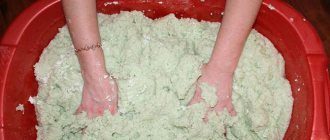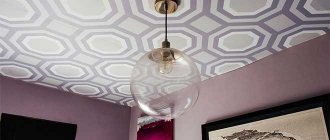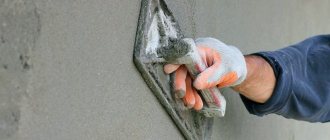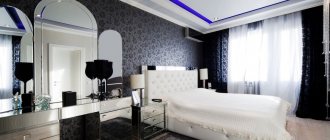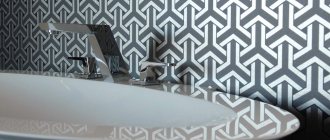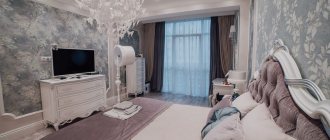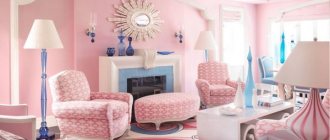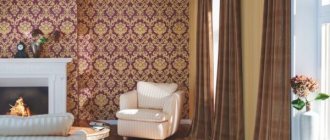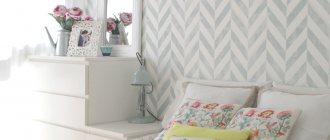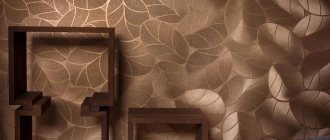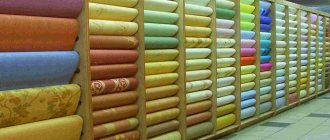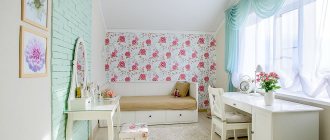Textile wallpaper has taken its rightful place among the popular wall decoration options. Fabric is an excellent finishing material that was immediately used to decorate rooms. Ancient Rome and Greece used fabric to decorate their homes. And for good reason, because the fabric has a lot of advantages and looks good in the interior.
What is fabric wallpaper?
Fabric wallpaper is a roll material for interior decoration, which includes several layers. The front side of such a canvas is a fabric, such as linen, polyester, jute or cotton. The composition of textile wallpaper may include paper, non-woven materials or non-woven materials. Previously, such products were called damask and decorated the walls of houses during the Empire, Baroque and Classicism.
Types of textile wallpaper
Textile wallpaper for walls is divided into two types:
- standard wallpaper rolls, 90-120 cm wide. This type of wallpaper consists of two layers: paper or non-woven, as well as a textile covering. The textile layer can be made of silks, cotton, viscose or jute;
- Seamless textile wallpaper is a single piece of fabric in roll form, approximately 295-320 cm wide.
Features and Specifications
Some features and characteristics of textile wallpaper:
- In terms of size, the roll can have a standard width from 0.53 to 1.2 m or be seamless, with dimensions of 3 m in width and up to 50 m in length.
- The service life of these fabric products is 10 years, models made from natural materials can last from 5 to 7 years.
- Models made of artificial fabric, polyester or jute are most often used for painting.
- When purchasing fabric wallpaper, you need to pay attention to the symbols on the roll.
Advantages of textile wallpaper
The main advantages of fabric wallpaper are:
- durability;
- contains only natural ingredients;
- interesting and sophisticated appearance;
- tolerate dry cleaning well;
- create additional sound insulation and thermal insulation.
It is also worth noting that the catalog of textile wallpapers is distinguished by a wide range of color palettes and various textures and designs.
Advantages and disadvantages
The main advantages and disadvantages of fabric models.
| pros | Minuses |
| They are universal. | They quickly absorb various odors and are quite easily soiled. |
| They have a long service life, are very practical and durable. | |
| They are environmentally friendly, do not fade in the sun and perfectly retain heat and a comfortable microclimate in the room. | They have a fairly high price. |
| Provide sound insulation. | They are difficult to glue. |
| Suitable for decorating walls and even ceilings with small irregularities. |
Advantages and disadvantages of fabric canvases
Among the main advantages of the coating are:
- steam conductivity;
- sound and heat insulation;
- naturalness of the materials used;
- air permeability, formation of uniform oxygen circulation indoors;
- wide range of products and unique design finishes.
The main disadvantages include mainly the inevitability of dust accumulation. Due to the presence of this factor, sticking in a nursery is not very recommended.
In addition, due to poor moisture resistance in the bathroom and kitchen, this coating is not very useful for long-term service.
Kinds
The most popular options and their features.
Velor (velvet or flock)
They have a velvety surface that is pleasant to the touch. These fabric models require careful and very careful handling; it is not advisable for them to come into contact with dust, steam or grease.
The photo shows a velor textile wall covering in the bedroom.
Jute
The most unpretentious type, which is natural, does not cause harm to health, does not require special care and has a fairly reasonable price. Products made from such a natural material as jute, despite their simple appearance, always look very elegant.
Liquid
These models are classified as textile because they contain several percent of silk or cotton fibers.
Silk
Thanks to the special surface that shimmers in the light, silk fabrics look elegant and sophisticated. This is a fairly common option that can also imitate a tapestry with texture.
The photo shows the living room and walls with golden textiles.
Linen
They are simple and economical. They look very elegant and are often used to decorate various interiors.
Synthetic based
Such fabric products are made on the basis of thin foam rubber, so they are very soft and elastic. Walls with such finishing acquire excellent insulating and soundproofing properties.
The photo shows a bedroom with turquoise textile wallpaper on a synthetic basis.
Felt
Can be made from natural felt or polypropylene foam. These products are very dense and perfectly mask small unevenness in the walls. Felt pile tolerates wet cleaning and cleaning well.
Jacquard
Elegant and luxurious, jacquard designs embrace practicality and comfort, durability and quality, and simply luxurious appearance.
Seamless
They have quite non-standard sizes, due to which they can cover a room with a minimum number of seams. This is a fairly convenient type of finish, which is placed horizontally on the wall and creates a covering with a single invisible seam.
Fabric based
Vinyl, non-woven and bamboo wallpapers on a fabric basis are easily pasted onto the wall surface and are particularly durable and wear-resistant.
Textile wallpapering technique
Textile wallpaper requires good preparation of the walls. Remove the old paint, level the walls, and, if necessary, wash off the dust accumulated under the wallpaper. Existing dents are covered with putty. Finally, cover the walls with two layers of primer.
Tools and materials needed:
- Fabric wallpaper;
- Putty knife;
- Gypsum putty;
- Primer;
- Water-based paint;
- Wallpaper glue;
- Paint roller;
- Rag;
- Marker;
- Detergent.
Work progress:
- The wallpaper roll is spread on the floor, the height is measured with an allowance of 5 cm and the first working strip is cut off.
- Similarly, cut out the second strip, attaching it to the first. The main task is to combine the drawings.
- At the next stage, when the strips are cut and numbered, you need to attach them to the wall to make sure that the joining patterns are located correctly.
- The glue, diluted according to the appropriate instructions, is spread on the initial strip, and for better impregnation, the ends are folded in the form of an accordion.
- After 15 minutes, begin gluing the first strip. The width of the strip is set aside from the window opening and a vertical line is drawn with a simple pencil along which the initial panel will be aligned.
- Place the cloth in the middle of the wall and begin to smooth it on the sides, avoiding the formation of bubbles.
Work should be carried out with the windows closed, there should be no drafts. The total drying time for textile wallpaper glued to walls is 24 - 48 hours.
Important! “Gluing is always done end-to-end only.”
Wide textile wallpaper is glued horizontally.
This will eliminate problems with aligning strips for the integrity of the pattern and unnecessary seams.
Despite the fact that gluing fabric wallpaper is quite a responsible and painstaking task, the resulting effect is guaranteed to please you. To ensure that the coating does not lose its luster over many years, it must be looked after. Every six months, dry clean with a lint-free cloth and a washing vacuum cleaner.
Design options and drawings
The most popular design options.
Floral patterns
Delicate and exquisite floral patterns create a special ambience in the room. Such fabric models always look elegant and luxurious and are a universal solution for many interiors.
Ornaments
They can become the main accent of the entire room. Geometric and openwork ornaments or patterned embroidery set a certain style for the room, transform the space and change its perception.
The photo shows a textile wall covering with an ornament and a bedroom interior.
Monograms
Orderly patterns of unusual patterns in the form of plants, with curls or with beautiful weaves, form an expensive interior and add a touch of luxury to the environment.
Strip
The most versatile and simple print that allows you to adjust the geometry of the space, giving it a proportional and harmonious appearance.
Cell
A strict and restrained check makes the interior of the room brighter and more interesting, and saturates the atmosphere with rich colors and contrasts.
The photo shows fabric wallpaper with a checkered print in the living room.
Fiberglass wallpaper
The composition of glass wallpaper includes glass fibers, which can have different thicknesses and shades. This material has a set of undeniable advantages:
- environmental friendliness;
- airtight qualities;
- long service life;
- heat-resistant characteristics;
- suitable for painting.
In addition, glass wallpaper can be used to cover not only walls. But also furniture items.
Fiberglass sheets perfectly hide all irregularities, chips and cracks, therefore they are suitable for covering brick, plasterboard and other wall surfaces.
From the photo of textile wallpaper you can see that this material looks luxurious and elegant in a residential interior. That is why they can become independent elements of any design that will complete and complement any interior.
Color spectrum
The color scheme allows you to create a certain atmosphere in the room and set its mood.
Beige
Brings tenderness, coziness and comfort to the room. Such a laconic design will undoubtedly add noble charm and a little rigor to the atmosphere.
The photo shows a textile wall covering made of jute in a bedroom interior.
Green
Organic green allows you to create a favorable atmosphere in the room, giving it its own character and maximum positive emotions.
The photo shows a bedroom and green textile wallpaper with birds.
Red
A multifaceted and rich color that has a special charm and can radically change the design of the entire room. Red textiles make the interior respectable, sophisticated and unique.
Black
It favorably emphasizes the style of the room and creates original and unusual contrasting accents in it. Black color brings special mystery and mysticism to the atmosphere.
White
Neutral white allows you to create unique and inimitable design compositions, and thereby add real interior chic to the room.
Grey
It fits harmoniously into any design, creates a calm atmosphere in it, and due to the quality of the shadow creates interesting illusions of volume on a plane.
Violet
Expressive purple always looks very sophisticated, extravagant and noble, and is an indicator of good taste.
Textile wallpaper manufacturers
There are many textile wallpapers on the market from different manufacturers. German textile wallpaper manufacturers Rasch have proven themselves well and are in good demand.
The wallpapers of this company are distinguished by a wide range of designs and colors. Also high quality textile wallpaper from Zuber.
Which styles are best to use?
This type of finish can be used in the following style solutions.
Classical
Textile products will harmoniously complement the concept of a classic interior and add special luxury and sophistication to it. A floral print, strict or symmetrical geometry will match the general mood of this style.
Eastern (Chinese and Japanese)
Plain textile wallpaper in neutral shades or models with unobtrusive patterns and ornaments will perfectly highlight this subtle, sophisticated and harmonious style. Jute products with companion wallpaper will add color and a touch of exoticism to the oriental interior.
The photo shows jute wall covering in an oriental style bedroom.
English
Fabric canvases are the main element in the design of the English style. They favorably complement the aristocracy and nobility of this style solution and give the interior coziness and warmth.
Modern
Laconic and discreet textile products in light and light colors fit perfectly into a modern and stylish design.
Provence
Decoration in the Provence style involves warm colors, floral patterns with ornate weaves that will successfully fit into a room imbued with French charm.
Tips for choosing textile wallpaper
Before making a choice in the direction of textile wallpaper, you need to take into account some expert advice:
- Felt and velor wallpapers absorb aromas and dust very quickly and strongly, so you should not use them to cover walls in the kitchen or dining room.
- You should take a special glue for textile wallpaper, preferably the one recommended by the manufacturer of the selected wallpaper.
- Wallpaper with a large-scale pattern will visually increase the space of the room.
- Textile wallpaper in rolls based on non-woven material is the best option for quickly gluing walls; they are much easier to glue than those based on paper or foam rubber.
- If necessary, cut a piece of textile wallpaper using only scissors.
- When pasting wallpaper, you should glue it from top to bottom and be sure to carefully smooth it with a rubber spatula.
- Do not allow glue to get on the front side of the wallpaper, as it may leave a stain.
- When gluing bamboo wallpaper, it is best to use “liquid nails” glue.
- If you are choosing textile wallpaper for painting, then be sure to ensure that there is only one batch, otherwise the texture of the wallpaper may differ.
- Plain textile wallpaper can be diluted with wallpaper with a pattern.
Room interior design ideas
Successful ideas for decorating walls in various rooms.
Bedroom
Fabric models, due to their environmental friendliness, allow you to bring natural warmth and comfort into the bedroom and create a pleasant microclimate in it. Cotton, linen or felt products are perfect for the recreation area.
The photo shows a bedroom and fabrics decorated with moldings on the wall.
Living room
Due to the unusual texture of textiles, a magnificent play of color is obtained that fills the living room with beauty, elegance and special luxury. Exquisite fabrics give the interior a very aesthetic appearance.
Kitchen
It is not advisable to use fabric models for this room, as they strongly absorb odors and therefore can very quickly become unusable. In the kitchen, vinyl, non-woven or liquid wallpaper that can be washed regularly would be appropriate.
The photo shows a dark textile fabric with plant patterns on the wall in the kitchen interior.
When to use fabric wallpaper for walls
This type of coating is suitable for design in bedrooms, children's rooms, offices, living rooms and dining rooms.
It is worth giving preference to this particular finishing coating if the interior predisposes to an atmosphere of luxury or, on the contrary, maximum eco-friendly orientation. Also an ideal solution when it is necessary to hide uneven walls - textured felt, jute or velor wallpaper.
Another important factor is environmental friendliness, for example, for children's rooms it is better to choose natural materials.
How to glue correctly?
Pasting will primarily depend on the basis on which the wallpaper is made. These products need to be glued quite carefully, joint to joint, and make sure that the glue does not get on the front side. It is advisable to smooth the canvas using a roller and not use a plastic spatula.
Which glue to choose?
You only need to choose special glue, which is indicated in the instructions on the roll. Using different mixtures or glue intended for other types of wallpaper can ruin such rather expensive materials.
Step-by-step gluing instructions
A few points to consider when gluing:
- Roll out the roll, measure the desired length, then carefully bend the sheet and cut along the fold.
- Using a roller or brush, apply a sufficient amount of glue to the cut and allow the material to soak.
- Carefully glue the canvas to the wall and smooth it well using a roller.
- Carefully inspect the wallpaper seams and, if necessary, go over them with a special roller so that they are glued as much as possible.
- Then leave the glued wallpaper to dry indoors for 24 to 48 hours. At the same time, it is desirable to maintain a comfortable temperature in the room and eliminate drafts.
Video
Visual video instructions for gluing.
Adhesive for textile wallpaper
It is best to use a special glue for textile wallpaper, namely the one recommended by the manufacturer of the selected wallpaper. It is advisable that the glue contains an antifungal agent to prevent mold from occurring.
It is also necessary to dilute the glue in a bucket and only with warm water. The ratio proportions are written on the glue packaging, and be sure to let the adhesive solution sit for 15-20 minutes and only then start gluing the walls.
Recommendations for selection
Basic tips for making the right choice:
- When choosing, you first need to consider the type of room and its purpose.
- Washable fabric-based products are suitable for the kitchen.
- Self-adhesive textile models that can be easily re-glued in case of damage would be appropriate in the nursery.
- For the bedroom, it is better to use products that accumulate dust the least.
Washable textile fabrics
There is a variety of products that do not have the main disadvantage of textiles - susceptibility to moisture. This is washable fabric wallpaper. They are made on the basis of non-woven fabric. The products contain materials that are protected from moisture. This allows you to perform not only dry, but also wet cleaning of products.
In addition, it becomes possible to use wallpaper in rooms with high humidity. A textile layer, represented by velor, silk or cotton, is applied to a non-woven base. Accordingly, the price of washable wallpaper is higher, which must be taken into account when purchasing. In the store you need to immediately clarify whether these products are washable or not.
Care and cleaning
Care instructions:
- To remove fresh stains and dirt, you can use a soap solution or absorb it with a cloth.
- Dust from the surface of the canvas should be removed using a vacuum cleaner.
- If after gluing there are glue stains left on the front side of the product, they can be removed using a damp sponge using vertical movements.
- Old or fairly strong stains can only be removed by re-sticking the problem area.
What types of felt wallpaper are there?
The basis of the products is thick paper. A thin layer of pressed felt is glued onto it, and the textile can be either natural or synthetic. In the latter case, polyester, microfiber or acrylic fibers are used for production. There is also a special type of material, which is foamed polypropylene: it is somewhat inferior in terms of environmental friendliness, but it guarantees increased wear resistance. Even light wet cleaning of the walls is allowed. Other artificial and natural fibers do not get wet; they can be cleaned, at most, with special dry foam.
Being dense in structure, felt fabric for wall decoration has considerable weight. Therefore, the glue for fixing it is selected from the category “for heavy wallpaper”, which is applied only to the wall. If you also cover the back of the felt with glue, there is a risk of staining the front side, and it is almost impossible to remove the tenacious compound from the pile without losing its decorative effect. But the main reason is the heaviness; if the material is saturated with adhesive, it will become heavy and extremely difficult to handle.
Felt wallpaper is not always glued to the wall in stripes like regular wallpaper (this is possible, but impractical due to visible joints).
To fix large-format products, the drapery method is used, that is, covering all walls with a single, uncut canvas. The process requires patience and good skill, so without helpers (ideally without a professional master) you shouldn’t even undertake it. By the way, due to its high price, this type of material is often sold by linear meters - for reasons of economy, so that there are no extra pieces left.
